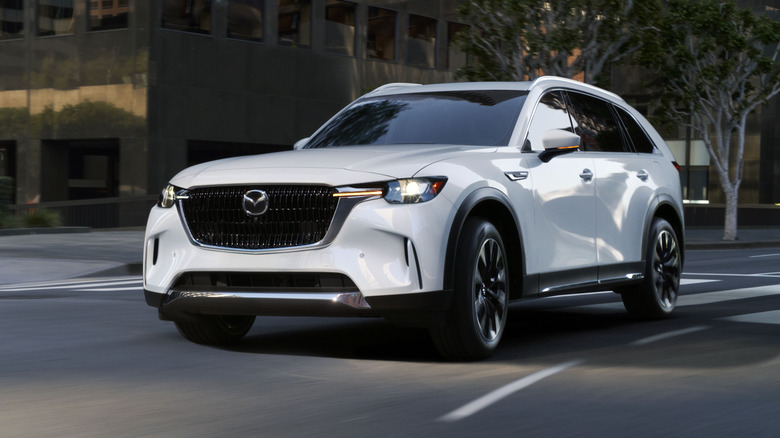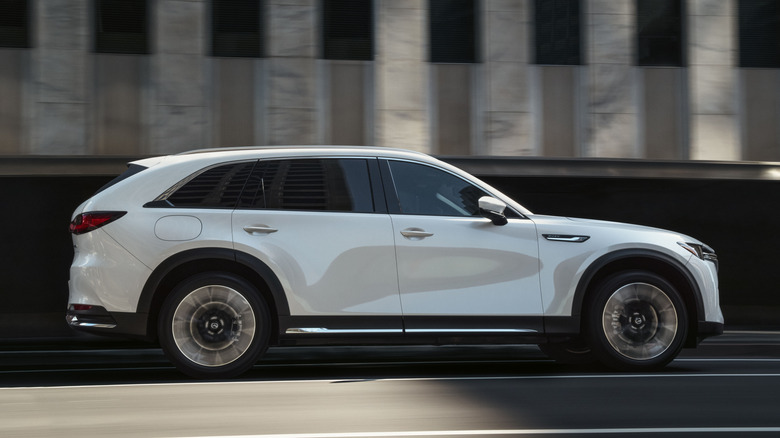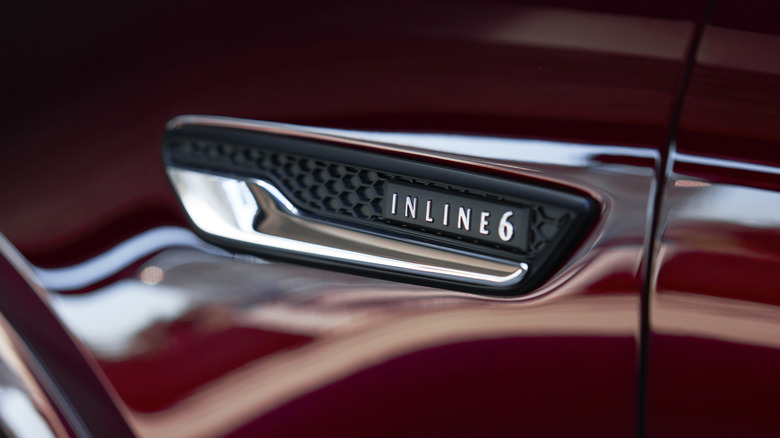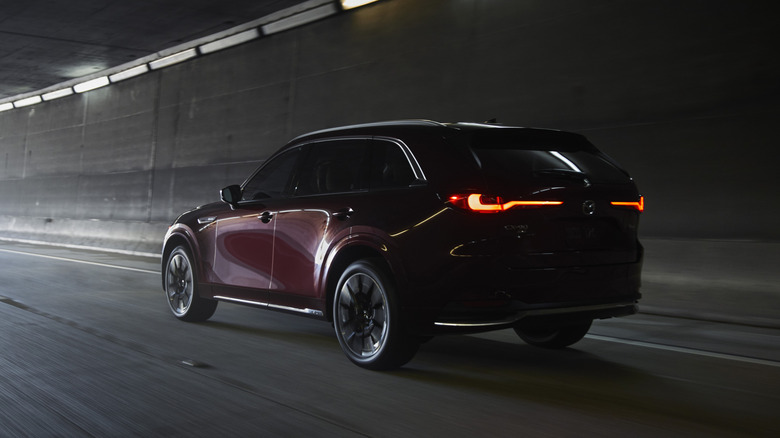5 Features That Make The Mazda CX-90 Stand Out From Other 3-Row SUVs
Three-row crossover SUVs have become more important for automakers than sedans. Maybe it doesn't make sense, considering families in the U.S. have fewer than two children on average. Yes, these vehicles offer greater versatility, but are also huge and less fuel-efficient. There are pros and cons to SUVs with third-row seating, that's for sure.
Still, people love them, and increasingly so. Thus, there is no shortage of three-row options on the market right now. Body-on-frame SUVs, hybrids, EVs, you name it, there is a three-row option. Even Mazda, a brand that launched its first SUV, the Tribute, in 2001, today has a three-row crossover SUV in its lineup.
The Mazda CX-90 is not just any three-row crossover SUV. It is cut from a different mold. Yes, it is the next in line after the CX-9 but shares almost nothing with that model. There is a reason why Mazda added a 0 to the name. A few of them, in fact. The CX-90 is almost like a maverick in the category that settled on drowsy, boring four-wheel appliances.
The CX-90 is not a paradigm shift, because similar vehicles already exist on the market, but not at CX-90 prices. Intrigued to learn more? Here are five features that make the Mazda CX-90 stand out from its three-row rivals.
Rear-biased platform for better driving dynamics
The biggest difference between premium and non-premium three-row crossovers has been the drivetrain architecture. The BMW X7, for example, is based on the rear-wheel-drive CLAR architecture, while the Toyota Grand Highlander utilizes Toyota's TNGA-K front-wheel-drive architecture. To differentiate from other non-premium automakers, Mazda launched a brand-new RWD-biased Large Architecture setup in 2019, joining automakers like BMW and Mercedes-Benz. The idea is to move the brand upmarket and double down on driving dynamics.
The CX-90 three-row crossover SUV was Mazda's first model on this new architecture. It has a longitudinally mounted engine for better weight distribution, improving on the already excellent Mazda driving signature. Indeed, the 2024 Mazda CX-90 rewrites the benchmarks with driving dynamics that belie its size. Of course, Mazda's expertise in chassis and suspension tuning played its part, but the RWD platform allowed the automaker to refine the handling even further. The CX-90 is agile, stable, steers nicely, and has little body roll. It's a thoroughly enjoyable crossover to drive, despite its gargantuan dimensions.
But it's not just the RWD platform that sets the CX-90 apart. Mazda's biggest car is also equipped with Kinematic Posture Control (KPC), borrowed from the super-fun MX-5 Miata roadster. The system can suppress body roll and stabilize the rear end by applying the brakes to the inner wheel.
The best part — you don't need to pay BMW money to have fun. The CX-90 starts at under $40k, or lower than the Grand Highlander and Honda Pilot. There is a catch, though — due to the RWD architecture, the CX-90 isn't as spacious in the third row as its rivals.
Turbocharged inline-six engines for higher refinement
The second huge feature in Mazda's Large Architecture is the introduction of turbocharged inline-six engines. Many crossover SUV models today are only offered with turbocharged inline-four engines, and Mazda's move will surely differentiate the CX-90 from its rivals.
Why is this important? Well, the inline-six engine has been making a comeback recently because it's easier to produce than a V6, and easily scalable from four-cylinder engines — you just need to add two cylinders. For buyers, though, it means even better smoothness than a V8. It's true, inline-six engines are inherently balanced. In other words, inline-sixes produce almost no vibration. They sound nice, too.
The CX-90 comes with a 3.3-liter turbocharged inline-six, available in two tunes. Non-S trims pack 280 hp and 332 lb-ft of torque, while the sporty Turbo S trims have 340 hp and massive 369 lb-ft of torque. However, you'll need premium fuel on the Turbo S to get those figures. With regular fuel, the horsepower drops to 319. Both are equipped with a 48-volt mild-hybrid system for efficiency and coupled with an eight-speed transmission.
The more powerful 340-hp is quite potent and engaging, with a 0-60 acceleration of 6.5 seconds. It's also good for 25 mpg combined, which is a fairly competitive figure. Still, buyers who want higher efficiency can go for the CX-90 plug-in hybrid. Sure, the PHEV has a 2.5-liter four-cylinder engine, but it can travel around 25 miles on electricity alone. Moreover, it produces a healthy 323 hp, the same 369 lb-ft of torque as the Turbo S, and gets to 60 in even quicker 5.9 seconds.
Upscale interior & a driver-focused cockpit
Jump inside the CX-90's cabin, and you'd be surprised by how luxurious it feels compared to rivals in its price range. Heck, the soft Nappa leather wouldn't be out of place in a German luxury car, let alone a Mazda. It's well thought-out, too. Everywhere you touch, the suppleness of the materials and the quality of the dials are evident.
The fit and finish are also excellent. Same for the choice of colors and materials. See, the CX-90 doesn't look flashy. There is no black piano plastic anywhere. No screens galore. Just surfaces that look and feel good. No fingerprints to ruin the look immediately after washing your car, though if you run into problems, Audi even sells a microfiber cloth so you can keep the screens pristine. The CX-90 is understated, but in a sea of flamboyant interiors from almost every luxury automaker, it looks positively delightful.
The CX-90 can be equipped with the Mazda Driver Personalization System, a sort of advanced memory seat function. This system has facial recognition to recognize you, but more importantly, measures where your eyes are, and then uses the Ideal Driving Position Assist to make you as comfortable as possible behind the wheel. Even without it, it's driver-focused, with a 10.3 or 12.3-inch infotainment that's not even a touchscreen in most trims. Instead, the center console shortcuts can operate most of the functions in Apple CarPlay and Android Auto, like opening Spotify or going back. You don't even need to raise your hand!
Standard i-ACTIV AWD
Most mid-size crossover SUVs come standard with two-wheel drive, including the Hyundai Palisade, Kia Telluride, and Toyota Grand Highlander. Even the supposedly rugged Honda Pilot also comes standard with front-wheel drive. Heck, even the luxurious Jeep Grand Cherokee L only comes with AWD as an option.
We understand — this helps manufacturers keep the base models more competitive and more efficient. But, once again, Mazda shows it's serious about breaking away from convention by offering the CX-90 only as an AWD vehicle — even the PHEV. The Japanese brand could have made the CX-90 even cheaper by offering a base RWD model, which would have still been different from its FWD foes, but that was apparently not good enough.
Still, it's not just any AWD — it's Mazda's i-ACTIV system, developed to increase agility and stability. The system can dynamically change the torque distribution to each axle to match the driving conditions. It's quick to react, too, as i-ACTIV uses various sensors installed throughout the vehicle and data analysis to predict wheel spin in advance and react accordingly.
Advanced i-ACTIVSENSE safety suite as standard
The Mazda CX-90 is one of the safest three-row crossover SUVs currently on sale. It comes with the usual passive safety features, such as dual front and side airbags, air curtains with rollover protection, and a driver's/front passenger's knee air bag. As a result, it earned the IIHS Top Safety Pick+ award and a five-star rating from the National Highway Traffic Safety Administration (NHTSA).
By driving well through corners, the Mazda CX-90 also has active safety in its genes. Of course, it's also equipped with Dynamic Stability Control and Traction Control as standard. But again, Mazda left nothing on the table and equips every CX-90 with its i-ACTIVSENSE safety suite. This advanced system uses cameras and radars all around the vehicle to monitor the road and mitigate or completely avoid potential accidents.
The i-ACTIVSENSE system has every modern active safety feature built in as standard. The Mazda Radar Cruise Control with Stop & Go can maintain distance to the vehicle in front, even in traffic. Lane Keep Assist & Lane Departure Warning make sure you stay in your lane. Blind Spot Monitoring notifies you if there is a vehicle in the mirror's blind spot. Rear Cross Traffic Alert tells you whether a vehicle approaches as you back up. Driver Attention Alert senses fatigue in the driver and recommends a break. The CX-90 even has Vehicle Exit Warning as standard, which can lock the door from being opened if a car or cyclist approaches the vehicle.





